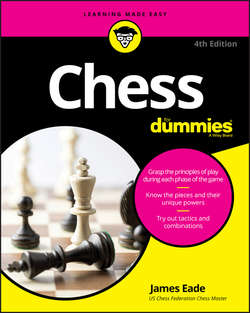Читать книгу Chess For Dummies - Eade James - Страница 13
На сайте Литреса книга снята с продажи.
Part 1
Laying the Groundwork for Champion Chess
Chapter 2
Getting to Know the Pieces and Their Powers
Galloping in an L-Formation: The Knight
ОглавлениеThe knight is a tricky piece, and getting comfortable with its movements usually takes a little practice. As its shape suggests, the knight derives from the cavalry of the armies of old. Because it can’t deliver checkmate against an opponent with only its own king to help, the knight is a minor piece, as is the bishop – but the knight’s powers are very different. Unlike the long-range bishop (which I describe earlier in this chapter), the knight loves combat in close quarters and is usually the first piece moved off the back rank and the first to come into contact with the opposing army. The knight is indeed hopping mad and ready to fight!
Figure 2-13 shows the knights’ starting place.
© John Wiley & Sons, Inc.
FIGURE 2-13: The knights begin here.
I like to think of the knight as a medieval knight on horseback with a lance. You can’t throw a lance very far, but if the bad guys get too close, they’re likely to get stabbed. Oddly, if an enemy can get past the lance and closer still to the knight, the knight is defenseless. (The knight would need to dismount, drop its lance, and draw a sword to fight at very close range – but this is too time-consuming, besides being against the rules of chess!) Strangely enough, although the knight is a strong attacking piece, it can’t control the squares right next to it.
The easiest way to understand the knight move is to think of it as an L-shape in any direction: two squares up and one over, or one square down and two over, or any such combination of two squares plus one. The knight captures just as the other chess pieces do, by replacing the piece or pawn occupying the square it lands on – not the players it jumps over. Figure 2-14a illustrates where the knight can move from the center of the board. The knight controls eight squares when positioned in the center of the board as opposed to two when it’s in one of the corners, as Figure 2-14b illustrates.
© John Wiley & Sons, Inc.
FIGURE 2-14: The knight’s possible moves, from the center and from a corner.
The knight must always move to a different-colored square than the one it occupies. This forced alternation between colors on every move is true of no other piece. If the knight is on a light square, it must move to a dark square, and vice versa.
The knight is much more effective when centralized – or positioned so that it occupies or attacks one of the four central squares. However, unlike the other pieces for which this general rule also holds true, the knight loves to be in the center of the action and is forced to retreat only when attacked by the lowly pawn (which I describe in the following section). Otherwise, the knight just holds its ground and dares you to capture it. The knight considers charging off into battle an honor and hates to watch while others are left to carry the day. That said, sometimes the knight needs to be defended.
The knight’s truly unique power is its ability to leap over chessmen, either its own or those of the enemy. In fact, this piece is the only one that can move off the back rank at the start of the game without a preliminary pawn move, as illustrated in Figure 2-15.
© John Wiley & Sons, Inc.
FIGURE 2-15: A knight hurdles a pawn.
THE KNIGHT’S TOUR
The knight’s tour is an interesting exercise where you position the knight anywhere on the chessboard and then move it to every other square on the board, without ever landing on the same square twice. Grandmaster George Koltanowski was famous for the knight’s tour and could do it without seeing the board (calling out the name of the square where the knight was to move). In fact, he once did it in front of more than 300 enthralled spectators on the occasion of his 90th birthday!
